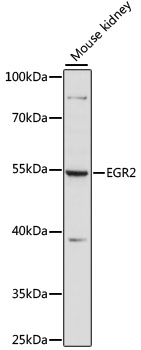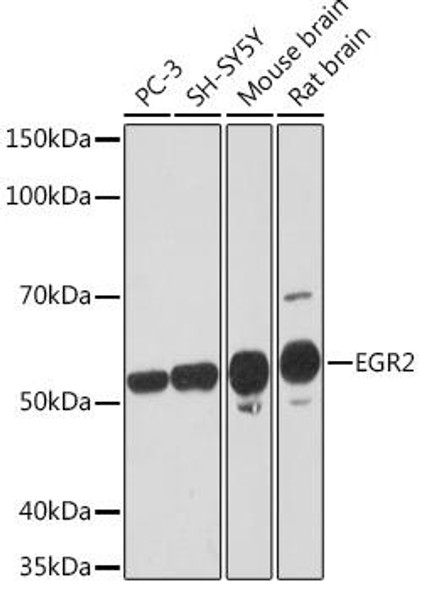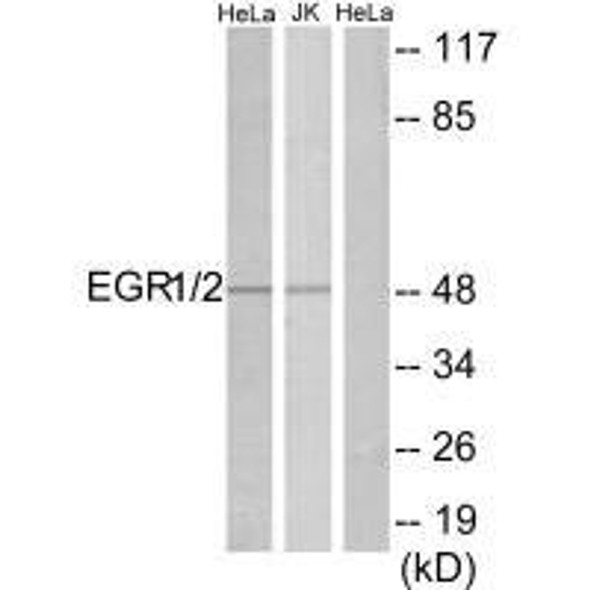Anti-EGR2 Antibody (CAB15053)
- SKU:
- CAB15053
- Product type:
- Antibody
- Reactivity:
- Mouse
- Host Species:
- Rabbit
- Isotype:
- IgG
- Antibody Type:
- Polyclonal Antibody
- Research Area:
- Epigenetics and Nuclear Signaling
Description
| Antibody Name: | Anti-EGR2 Antibody |
| Antibody SKU: | CAB15053 |
| Antibody Size: | 20uL, 50uL, 100uL |
| Application: | WB |
| Reactivity: | Mouse |
| Host Species: | Rabbit |
| Immunogen: | A synthetic peptide corresponding to a sequence within amino acids 200-300 of human EGR2 (NP_000390.2). |
| Application: | WB |
| Recommended Dilution: | WB 1:500 - 1:2000 |
| Reactivity: | Mouse |
| Positive Samples: | mouse kidney |
| Immunogen: | A synthetic peptide corresponding to a sequence within amino acids 200-300 of human EGR2 (NP_000390.2). |
| Purification Method: | Affinity purification |
| Storage Buffer: | Store at -20°C. Avoid freeze / thaw cycles. Buffer: PBS with 0.02% sodium azide, 50% glycerol, pH7.3. |
| Isotype: | IgG |
| Sequence: | LAYP PPPS YPSP KPAT DPGL FPMI PDYP GFFP SQCQ RDLH GTAG PDRK PFPC PLDT LRVP PPLT PLST IRNF TLGG PSAG VTGP GASG GSEG PRLP GSSS A |
| Gene ID: | 1959 |
| Uniprot: | P11161 |
| Cellular Location: | Nucleus |
| Calculated MW: | 44kDa/50kDa |
| Observed MW: | 55kDa |
| Synonyms: | EGR2, AT591, CMT1D, CMT4E, KROX20 |
| Background: | The protein encoded by this gene is a transcription factor with three tandem C2H2-type zinc fingers. Defects in this gene are associated with Charcot-Marie-Tooth disease type 1D (CMT1D), Charcot-Marie-Tooth disease type 4E (CMT4E), and with Dejerine-Sottas syndrome (DSS). Multiple transcript variants encoding two different isoforms have been found for this gene. |
| UniProt Protein Function: | EGR2: Sequence-specific DNA-binding transcription factor. Binds to two specific DNA sites located in the promoter region of HOXA4. Defects in EGR2 are a cause of congenital hypomyelination neuropathy (CHN). Inheritance can be autosomal dominant or recessive. Recessive CHN is also known as Charcot- Marie-Tooth disease type 4E (CMT4E). CHN is characterized clinically by early onset of hypotonia, areflexia, distal muscle weakness, and very slow nerve conduction velocities. Defects in EGR2 are a cause of Charcot-Marie-Tooth disease type 1D (CMT1D). CMT1D is a form of Charcot- Marie-Tooth disease, the most common inherited disorder of the peripheral nervous system. Charcot-Marie-Tooth disease is classified in two main groups on the basis of electrophysiologic properties and histopathology: primary peripheral demyelinating neuropathy or CMT1, and primary peripheral axonal neuropathy or CMT2. Neuropathies of the CMT1 group are characterized by severely reduced nerve conduction velocities (less than 38 m/sec), segmental demyelination and remyelination with onion bulb formations on nerve biopsy, slowly progressive distal muscle atrophy and weakness, absent deep tendon reflexes, and hollow feet. Defects in EGR2 are a cause of Dejerine-Sottas syndrome (DSS); also known as Dejerine-Sottas neuropathy (DSN) or hereditary motor and sensory neuropathy III (HMSN3). DSS is a severe degenerating neuropathy of the demyelinating Charcot-Marie- Tooth disease category, with onset by age 2 years. DSS is characterized by motor and sensory neuropathy with very slow nerve conduction velocities, increased cerebrospinal fluid protein concentrations, hypertrophic nerve changes, delayed age of walking as well as areflexia. There are both autosomal dominant and autosomal recessive forms of Dejerine-Sottas syndrome. Belongs to the EGR C2H2-type zinc-finger protein family. 2 isoforms of the human protein are produced by alternative splicing. |
| UniProt Protein Details: | Protein type:DNA-binding; C2H2-type zinc finger protein; EC 6.3.2.- Chromosomal Location of Human Ortholog: 10q21.1 Cellular Component: cytoplasm; nucleus Molecular Function:protein binding; ubiquitin protein ligase binding; metal ion binding; chromatin binding; transcription factor activity; ligase activity Biological Process: myelination; transcription from RNA polymerase II promoter; fat cell differentiation; facial nerve structural organization; rhombomere 5 formation; positive regulation of transcription, DNA-dependent; motor axon guidance; response to insulin stimulus; peripheral nervous system development; Schwann cell differentiation; rhythmic behavior; protein sumoylation; learning and/or memory; rhombomere 3 formation; positive regulation of transcription from RNA polymerase II promoter; brain development; protein export from nucleus; regulation of ossification; brain segmentation; regulation of neuronal synaptic plasticity; negative regulation of apoptosis Disease: Neuropathy, Congenital Hypomyelinating Or Amyelinating, Autosomal Recessive; Hypertrophic Neuropathy Of Dejerine-sottas; Charcot-marie-tooth Disease, Demyelinating, Type 1d |
| NCBI Summary: | The protein encoded by this gene is a transcription factor with three tandem C2H2-type zinc fingers. Defects in this gene are associated with Charcot-Marie-Tooth disease type 1D (CMT1D), Charcot-Marie-Tooth disease type 4E (CMT4E), and with Dejerine-Sottas syndrome (DSS). Multiple transcript variants encoding two different isoforms have been found for this gene. [provided by RefSeq, Oct 2008] |
| UniProt Code: | P11161 |
| NCBI GenInfo Identifier: | 33112654 |
| NCBI Gene ID: | 1959 |
| NCBI Accession: | P11161.3 |
| UniProt Related Accession: | P11161 |
| Molecular Weight: | 50 kDa |
| NCBI Full Name: | E3 SUMO-protein ligase EGR2 |
| NCBI Synonym Full Names: | early growth response 2 |
| NCBI Official Symbol: | EGR2 |
| NCBI Official Synonym Symbols: | CHN1; AT591; CMT1D; CMT4E; KROX20 |
| NCBI Protein Information: | E3 SUMO-protein ligase EGR2 |
| UniProt Protein Name: | E3 SUMO-protein ligase EGR2 |
| UniProt Synonym Protein Names: | AT591; Early growth response protein 2; EGR-2; Zinc finger protein Krox-20 |
| Protein Family: | E3 SUMO-protein ligase |
| UniProt Gene Name: | EGR2 |
| UniProt Entry Name: | EGR2_HUMAN |







